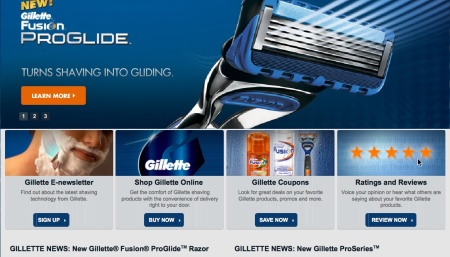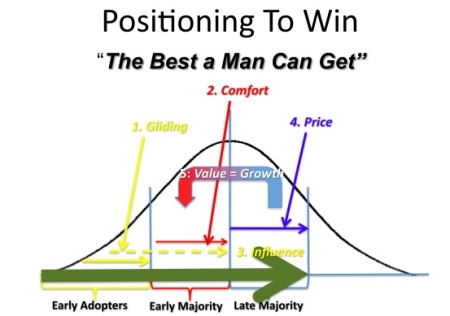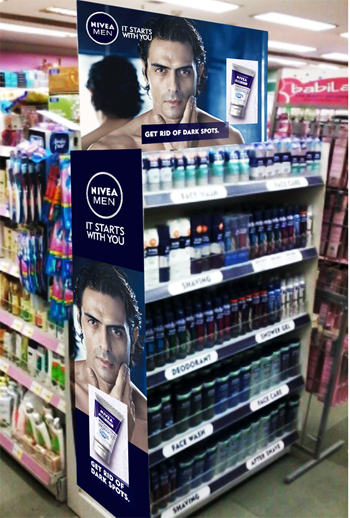Times are tough for marketers right now. So let me take you away to
an oasis of consumer loyalty where huge margins and a ridiculously
dominant market share are the norm. Where private label is non-existent
and your biggest competitor is your second string product. No, it’s not a
fantasy. It’s the alternative marketing universe occupied by Gillette.
Thanks to years of product innovation and heavy investment in
marketing and advertising, Gillette occupies perhaps the most dominant
position of any of the major global consumer goods brands with an
estimated 70% share of the global razor blade category. Common sense
might suggest that if you found yourself in this envious position you
would sit back and count the billions of dollars in annual revenues that
this market share delivers. But Gillette is owned by P&G, and while
even the best marketing company in the world can’t improve much beyond
that level of market share – there are plenty of other levers to pull to
generate shareholder value. And those levers provide brand managers
with a vital, best practice lesson in growing a brand’s contribution
even when market share remains constant.
Gillette usually practices positive cannibalization. Gillette launched its five bladed
Fusion line in 2006 with a 40% price premium over Mach3, its previous
three bladed offering. Despite the fact that both lines generate
significant profits, with such a huge share of the shaving market it
makes more sense for Gillette to focus its marketing resources on
switching its own customers from Mach 3 to the more profitable Fusion
line than trying to win any more share from competitors. That’s why
Gillette is now spending millions to compete against itself with ads and
online comparisons that attempt to convince its Mach 3 consumers that
their current razor is simply not good enough and to trade up to Fusion.
A year ago Fusion started a TV campaign called “Nudging Disciples” in
which ads argued that “five is better than three,” referring to the
different blade counts of Fusion and Mach3. The spot shows Tiger Woods,
Derek Jeter and Roger Federer literally knocking Mach3 razors out of
men’s hands with a golf ball, baseball and tennis ball, respectively.
“Sometimes you need a little push to let go of your Mach3 razor,” the
narrator says. While it may seem crazy to spend millions to compete
against yourself, the margin differences mean that this will deliver a
better ROI than targeting the small number of remaining non-Gillette
consumers over to the brand. Targeting existing customers is usually
easier and the conversion rates are better.
Extend the brand! Gillette have a billion dollar brand equity – use it to
enter and take control of other related categories. For Gillette that
has meant a successful foray into the “software” side of shaving with up
to a 50% share in the shaving cream category in many countries and a
growing slice of deodorants and shampoos too.
Finally, stay frosty. Today’s market dominator could
end up being tomorrow’s has-been brand. The vast majority of spend on
consumer goods marketing is spent defensively to maintain share, not
grow it. No surprise therefore that Gillette is one of the brands linked
to the hottest TV series of 2009 – the second series of True Blood from
HBO. Their fictional tie-in campaign shows a vampire endorsing Fusion
as the best shave for the undead. It will deliver a huge amount of
defensive awareness while keeping the brand contemporary and hip in the
never ending battle to stay fresh.
So take some comfort with our shrinking share, puny margins and tiny
marketing budget. I think I have it tough? Look how hard Gillette
has to work with 70% share, 3000% mark up and no real competition. Who
said brand management was ever easy?
It is a very popular brand among the youth. Gillette's new innovations
in brand strategy helps the company to improve its brand value day by
day.
- Right from the very beginning Gillette's vision is to establish a
brand value by delivering consumer value faster through innovation in
customer leadership.
- Gillette did revolutionize the market of shaving razor in 1971 by introducing the twin-blade razor named Trac II.
- Gillette's brand value is increasing by reason of its innovation in
branding. It has introduced Fusion through which it is attracting more
men to go for the Gillette shave.
- The Proctor & Gamble, who owned the Gillette brand, has
introduced some attractive products with its razor through a fusion
brand which comprises Fusion Hydra Gel men shaving gel and Hydra Cool
aftershave sets.
- Gillette has put up a lot of effort on building their homepage which
is very popular. It looks cool and has a nice pale-blue shade which
reflects the real power under it.
- In 2005, Gillette claimed the 15th position in the Inter brand's Top 100 Global Brands' list.
- Gillette's brand value was 17,534 million dollars in 2005, while in the previous year 16,723 million dollar
Over
the past two decades, Gillette has been at the forefront of innovation
in the male grooming category, becoming a brand that is synonymous with
shaving. In a bid to retain its brand status, Gillette launched the
Fusion ProGlide razor in June 2010 in an attempt to address men’s
shaving comfort needs.
With research showing that 65% of males still experience shaving
discomfort, Gillette decided to extend its Fusion shaving range with the
introduction of the ProGlide razor. Its several high-precision
innovations together promised reduced “tug and pull” for men during
shaving, thereby enhancing both performance and comfort.
The immediate market success of the Fusion ProGlide razor is down, in
large part, to Gillette’s shift towards a more consumer-based marketing
strategy. With a unique pre-launch marketing campaign and experiential
marketing efforts, Gillette has successfully responded to male consumer
skepticism surrounding the launch of Fusion ProGlide, allowing the
product to speak for itself.
By focusing its marketing efforts on the consumer, Gillette has
managed to successfully position the Fusion ProGlide razor across the
entire consumer adoption lifecycle. In doing so, Gillette has ensured
market growth for the brand moving forwards.
- See more at:
http://www.marketline.com/blog/gillette-fusion-proglide-using-consumer-focused-marketing-to-instill-brand-confidence/#sthash.x5KZfYM8.dpuf
Positioning to Win for Maximum Impact
As we all know, Proctor and Gamble, Gillette’s parent company, is a
brand and marketing powerhouse. And Gillette is an established market
leader in the razor space and has been so for decades.
This means that a big part what it takes to capture and exploit the
Early Majority is in place already with brand leadership and millions of
satisfied users around the globe.
In it’s current state, you can see that the current product messaging
is actually talking to Early Adopters, NOT the Majorities. The
marketing question is, is this it for now, or is there more we can do to
exploit the new
Fusion Pro Glide product?
If we look at positioning best practice, the answer is yes!
Here’s a structural model of how this can work (by segment):

1. Early Majority
A. Leadership
These buyers appreciate and will pay a premium for the leading product
in the category, making this is a clear sweet spot for this particular
product now.
As mentioned earlier, the key to effective positioning here is
connecting the “what’s in it for me?” question in the clearest terms
possible that yields maximum results. In this case, Gillette has opted
for a
“Turn Shaving Into Gliding” message, which begs the question, “What does
Gliding mean?” It glides, perhaps, but so what? What does
Gliding do for me?
And yet buried deep in the current presentation, there is an answer…
all the wonderful product features, YouTube videos, NASCAR endorsements,
and
Dream Job promotions are designed, perhaps indirectly to support the message that
Fusion Pro Glide delivers
“Gillette’s most comfortable shave ever.”
That’s what Early Majority buyers looking for. Now we get it! The big
benefit, the compelling reason to buy. It was there, but buried by the
Gliding
message. All we need to do is call this message out front and center.
And if you want to be slick about it, again from the current messaging,
add…
“Guaranteed.”
Roll it all up, here is what’s in it for the Early Majority buyer. Pro Glide Fusion is:
Gillette’s most comfortable shave ever. Guaranteed.
2. Late Majority
Research I found seems to indicate support my Dad’s feelings about
shaving. It is a necessary evil, something we have to do due for social
conventions, but inconvenient at best. This attitude sets up
commodity-style, low-price
“just get it over with” thinking.
As it stands, Gillette has a dizzying array of lower cost blades and razors from earlier category leaders
Fusion and
Mach 3 to a whole slew of disposables. “Dizzying” is the operative word. Extremely complex.
What we need here is a clear roadmap of products, perhaps broken down into 1. blades and 2. disposables from
Good to
Better and Pro Glide in the role of
BEST… with a blade price of
“lowest” to
“more” to
“most” expensive.
Your Choice.
And since
Fusion Pro Glides fit in millions of
Fusion
handles already in the market, it is easy to slip in a free blade and
coupon for later purchase in the package to engage these established
buyers and get them into the pipeline. We have to assume this is in the
works already.

3. The Best A Man Can Get: Positioned for Growth Across the Lifecycle
If we go back to Gillette’s core brand, we can see we have the platform we need to cut across the whole razor line…
“the best a man can get.”
I was surprised to see that it is still alive and core… embedded right
in the logo treatment itself. As one would expect with a brand of this
caliber, it was like seeing an old friend. Powerful indeed.
This offers up a value platform with the opportunity to move customers up the ladder from
“cheap” to
Better and
Best products and from a commodity buyer to a premium one. I call this
Marketing JuJitsu.
Here is where positioning focused on costs per shave and other metrics
commodity buyers think about can come into play to demonstrate brand
value to the these buyers too.
Example:
Let’s assume we can get two-weeks of shaves out of one
Fusion Pro Glide
blade. (Note: I have gotten up to four weeks, even with my heavy
beard). Two weeks of comfortable shaves at $3 per blade equals
approximately $.21 per shave. Let’s assume you can buy a disposable for
$.20 per razor that safely delivers a shave, or two. Now the value
proposition to this segment can be turned around to something like…
“For just pennies extra a day you can move up to Gillette’s closest, most comfortable shave.
Take the challenge to see and feel the difference for yourself.
Low(est) cost and most comfort from Gillette… The Best A Man Can Get.”
Here is what the structure looks like all together with above.

As you can see, now we have a Strategic Framework capable of positioning
Fusion Pro Glide in multiple segments across the Lifecycle simultaneously under the
Best A Man Can Get Brand
Platform:
- Early Adopter with Glide
- Early Majority with Comfort
- Convert Early Adopters to Influencers building on incentives and promotions
- Create simple and understandable tiers of lower cost products for Late Majority
- Drive a Cost per Shave Value Message and convert Commodity into Premium buyers
Over
the past two decades, Gillette has been at the forefront of innovation
in the male grooming category, becoming a brand that is synonymous with
shaving. In a bid to retain its brand status, Gillette launched the
Fusion ProGlide razor in June 2010 in an attempt to address men’s
shaving comfort needs.
With research showing that 65% of males still experience shaving
discomfort, Gillette decided to extend its Fusion shaving range with the
introduction of the ProGlide razor. Its several high-precision
innovations together promised reduced “tug and pull” for men during
shaving, thereby enhancing both performance and comfort.
The immediate market success of the Fusion ProGlide razor is down, in
large part, to Gillette’s shift towards a more consumer-based marketing
strategy. With a unique pre-launch marketing campaign and experiential
marketing efforts, Gillette has successfully responded to male consumer
skepticism surrounding the launch of Fusion ProGlide, allowing the
product to speak for itself.
By focusing its marketing efforts on the consumer, Gillette has
managed to successfully position the Fusion ProGlide razor across the
entire consumer adoption lifecycle. In doing so, Gillette has ensured
market growth for the brand moving forwards.
- See more at:
http://www.marketline.com/blog/gillette-fusion-proglide-using-consumer-focused-marketing-to-instill-brand-confidence/#sthash.x5KZfYM8.dpuf



 The NIVEA FOR MEN team devised marketing strategies
to deliver its objectives. These strategies set out how the objectives
would be achieved within the designated budget set by the management
team. This focus on product development combined with an emphasis on
consumer needs is a key differentiator for NIVEA FOR MEN. It is a major
reason why in the UK the brand is still the market leader in the male
facial skincare market.
The NIVEA FOR MEN team devised marketing strategies
to deliver its objectives. These strategies set out how the objectives
would be achieved within the designated budget set by the management
team. This focus on product development combined with an emphasis on
consumer needs is a key differentiator for NIVEA FOR MEN. It is a major
reason why in the UK the brand is still the market leader in the male
facial skincare market. ‘As
is our confidence, so is our capacity’ wrote William Hazlitt, famous
English writer from 1800 and his words ring true even today. Take for
example Nivea and their new campaign, ‘It starts with you.’ The brand
recently launched their new skin care range for men with Arjun Ramphal
as their brand ambassador. With an objective to transform men’s skin
care industry, Nivea introduces its range with the new tagline.
‘As
is our confidence, so is our capacity’ wrote William Hazlitt, famous
English writer from 1800 and his words ring true even today. Take for
example Nivea and their new campaign, ‘It starts with you.’ The brand
recently launched their new skin care range for men with Arjun Ramphal
as their brand ambassador. With an objective to transform men’s skin
care industry, Nivea introduces its range with the new tagline. 





